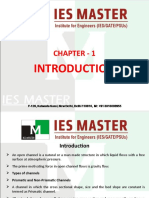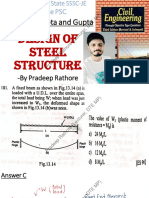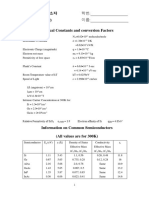Assignment 5 Mesh Analysis
Uploaded by
Sajan MaharjanAssignment 5 Mesh Analysis
Uploaded by
Sajan MaharjanNational college of Engineering
Basic Electrical Engineering
Assignment on Mesh Analysis
Solve the following using mesh analysis:
Determine the mesh currents I1, I2 and I3 in figure 1. Also determine power supplied by each all voltage sources
[Ans: I1=-5.037A, I2=-2.0522A, I3=-9.701A]
6Ω 2Ω
I1 I2
4Ω
2Ω
10Ω
20V 10V
5Ω
I1
I2 I3
2Ω 4Ω
50V
I3 I4
3Ω
25V
6Ω 4Ω
Figure 1 Figure 2
1. Determine the mesh currents I1, I2, I3 and I4 in figure 2. [Ans: I1=1.181A, I2=-0.454A, I3=-2.037A, I4=0.555A]
2. Determine the mesh currents in figure 3. [Ans: I1= -0.238A, I2= -0.857A and I3=1.143A]
10V
6Ω
I1
12Ω 8V
6V 20Ω 3Ω
2Ω 2Ω
I2 I3 10Ω
10V 2A
5Ω
12V
Figure 3 Figure 4
3. Determine current in 5 Ω resistor in figure 4. [Ans: 3.353 A]
4. Use loop current method to find the currents through each of the resistance for the network given in
figure 5 . [Ans: 7.726A, 1.0816A, 3.7086A, 2.6270A, 6.0651A, 1.1921A]
5. Obtain the current in 1 ohm resistor in the following circuit in figure 7. [Ans: 2.79A]
6. Apply loop current method to find loop currents in the circuit shown in figure 8. [Ans: 3.75A, 0 and 1.25A]
7.
10Ω 5Ω
I1
5Ω 1Ω 10Ω 10V
5A
10A
Figure 7
10Ω
1Ω 2Ω
10Ω 10Ω 10Ω 3Ω
7A
7V
100V 50V
10Ω 1Ω
2Ω
Figure 8 Figure 10
8. Calculate the current in 3 Ω resistor for the circuit shown in figure 10. [Ans: 0.5A]
9. Obtain the branch currents in the unbalanced bridge circuit shown in figure 11. Also determine the voltage
drop across AC and the equivalent resistance between terminals A and C in the bridge. [Ans: 2.4518V;
3.1673Ω]
10. Determine the node voltage and the current through the resistors using mesh method for the network
shown in figure 12. [Ans: 0V, 3.05V, 3.36V and 12V]
11. Determine the current through Galvanometer with resistance 1 ohm in between B and D as shown in
figure 13. Also calculate power delivered by the source.
B
3A
2Ω 4Ω
A
6Ω G 5Ω 6Ω
A C
3Ω 1Ω
4Ω 3Ω
12V 2Ω
6V
9A 1Ω
D D B
1Ω
Rint=2Ω
1Ω 1Ω
Figure 12
E=4V
Figure 11 C
Figure 13
You might also like
- Paschimanchal Campus: Tribhuwan UniversityNo ratings yetPaschimanchal Campus: Tribhuwan University42 pages
- İMÜ331 - Soil Mechanics I: Seepage Flow Nets100% (1)İMÜ331 - Soil Mechanics I: Seepage Flow Nets17 pages
- Measuring The Efficiency of Decision Making Units: CharnesNo ratings yetMeasuring The Efficiency of Decision Making Units: Charnes16 pages
- .Design and Analysis of Non-Pneumatic Tyre (NPT) With Honeycomb Spokes Structure100% (1).Design and Analysis of Non-Pneumatic Tyre (NPT) With Honeycomb Spokes Structure5 pages
- 10 - Hydraulic Jump and Its Usefulness in The Design of Irrigation StructuresNo ratings yet10 - Hydraulic Jump and Its Usefulness in The Design of Irrigation Structures18 pages
- Objective Questions (106 To 120) : SSC-JE, AE (PSC), RRB EtcNo ratings yetObjective Questions (106 To 120) : SSC-JE, AE (PSC), RRB Etc35 pages
- Entrance Examination Model Questions of Nepal Engineering College HSEB Notes0% (1)Entrance Examination Model Questions of Nepal Engineering College HSEB Notes3 pages
- Module-37A: Analysis of Beam Sections at Transfer and Service Loads100% (1)Module-37A: Analysis of Beam Sections at Transfer and Service Loads2 pages
- Fluid Mechanics and Hydraulic MachineryNo ratings yetFluid Mechanics and Hydraulic Machinery45 pages
- Amendment No. 1 November 2014 TO Is 4326: 2013 Earthquake Resistant Design and Construction of Buildings - Code of PracticeNo ratings yetAmendment No. 1 November 2014 TO Is 4326: 2013 Earthquake Resistant Design and Construction of Buildings - Code of Practice9 pages
- Problem Set Soil Mechanics Ready To Print CE PaperNo ratings yetProblem Set Soil Mechanics Ready To Print CE Paper6 pages
- Gate Question Papers Download Civil Engineering 2003No ratings yetGate Question Papers Download Civil Engineering 200318 pages
- Analysis and Design of T-Girder Bridge AT Dhobi Khola, Gahukharka-SindhuliNo ratings yetAnalysis and Design of T-Girder Bridge AT Dhobi Khola, Gahukharka-Sindhuli54 pages
- Civil V Structural Analysis II (10cv53) NotesNo ratings yetCivil V Structural Analysis II (10cv53) Notes90 pages
- Chapter 2 - Lineal Circuit Analysis Theorems - ExercisesNo ratings yetChapter 2 - Lineal Circuit Analysis Theorems - Exercises8 pages
- Advanced Sensor Research - 2022 - EdbergNo ratings yetAdvanced Sensor Research - 2022 - Edberg12 pages
- Journal Pre-Proof: Journal of Molecular StructureNo ratings yetJournal Pre-Proof: Journal of Molecular Structure57 pages
- Technical Sciences Grade 11 Term 1 Revision Material 2024No ratings yetTechnical Sciences Grade 11 Term 1 Revision Material 202432 pages
- Lesson 2 First Law of Thermodynamics: Thermal Energy and WorkNo ratings yetLesson 2 First Law of Thermodynamics: Thermal Energy and Work17 pages
- Magnetic Effect of Electric Current Pyqs Nsejs0% (1)Magnetic Effect of Electric Current Pyqs Nsejs4 pages
- Review of Permanent-Magnet Brushless DC Motor Basic DrivesNo ratings yetReview of Permanent-Magnet Brushless DC Motor Basic Drives28 pages
- A Mathematical Model For Enzyme Kinetics: Multiple Timescales AnalysisNo ratings yetA Mathematical Model For Enzyme Kinetics: Multiple Timescales Analysis9 pages
- Grade 11 Semester Exam Paper & Material Outline - Semester 2No ratings yetGrade 11 Semester Exam Paper & Material Outline - Semester 24 pages
- Inspection Checklist For Installation of Earthing System123 PDFNo ratings yetInspection Checklist For Installation of Earthing System123 PDF1 page
- Selectable Candela Evacuation Signals: Strobe Horn/Strobe HornNo ratings yetSelectable Candela Evacuation Signals: Strobe Horn/Strobe Horn4 pages
- Engineering Encyclopedia: Electric MotorsNo ratings yetEngineering Encyclopedia: Electric Motors53 pages
- Experiment 04 Identification of Carboxylic AcidNo ratings yetExperiment 04 Identification of Carboxylic Acid8 pages

























































































